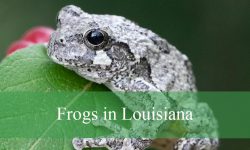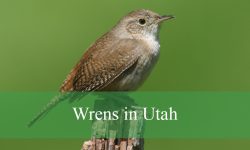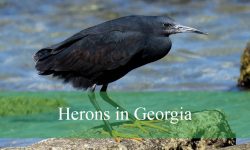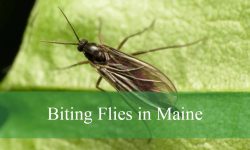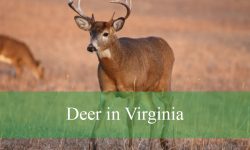Texas is home to an impressive variety of birds of prey, from powerful eagles and hawks to agile falcons and mysterious owls. With its diverse landscapes, ranging from open prairies and deserts to dense forests and wetlands, the state provides ideal habitats for these raptors. Observing them in the wild can be a thrilling experience, whether they are soaring high in the sky, perched silently on a branch, or gliding gracefully over open fields.
This guide will help you identify 33 different birds of prey in Texas, with detailed descriptions of their appearance, behavior, and preferred habitats. The information provided will make it easier to recognize and appreciate these magnificent birds in their natural environment.
Common Birds of Prey Found in Texas
White-tailed Kite
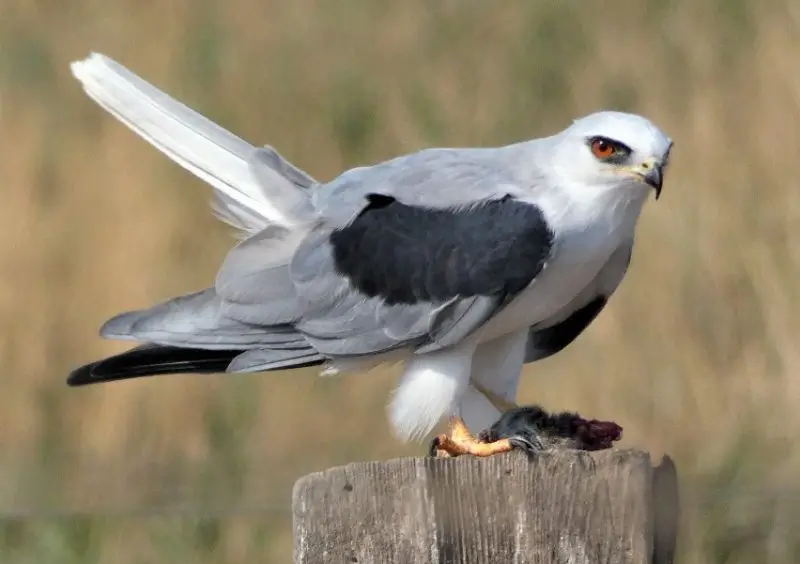
White-tailed Kites are medium-sized raptors notable for their striking black shoulder patches, white body, and long, narrow tail. Adults have pale gray wings and a white head, while juveniles appear slightly darker with more muted markings. Their hovering flight, often seen over open fields, is a hallmark of their hunting behavior.
Adults measure 14 to 16 inches in length, with a wingspan of 39 to 43 inches. Their long wings and tail provide exceptional maneuverability, and their sharp talons and hooked beak are designed for capturing rodents and small birds. Males and females are similar in appearance and hunting efficiency.
In Texas, White-tailed Kites inhabit open grasslands, agricultural fields, and savannas. They primarily hunt small mammals such as mice, voles, and other rodents. Their hunting technique involves hovering high above the ground, scanning for movement, and then dropping swiftly to capture prey with pinpoint accuracy.
Red-tailed Hawk
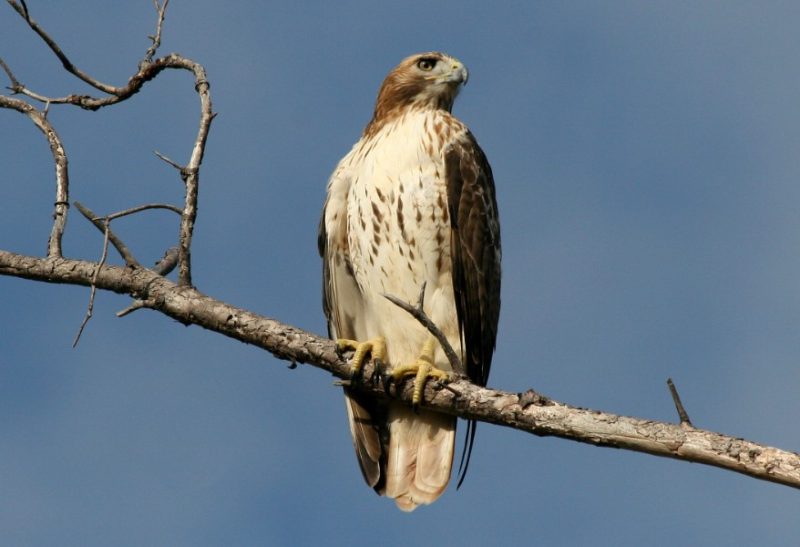
The Red-tailed Hawk is one of the most recognizable birds of prey in Texas, easily identified by its broad, rounded wings and the characteristic rusty-red tail that gives the species its name. Adults have a brown back, pale underparts, and a streaked belly band, while their eyes are dark and piercing, giving them a keen, observant look. Juveniles lack the red tail but display similar markings and can be distinguished by their mottled brown coloration.
This hawk is a large raptor, with a wingspan ranging from 43 to 57 inches and a body length of 18 to 26 inches. Males are slightly smaller than females, but both share powerful talons and a hooked beak designed for tearing flesh. Their size and strength make them formidable hunters capable of capturing a wide range of prey.
Red-tailed Hawks are versatile predators, feeding primarily on small mammals such as rabbits, squirrels, and rodents, but they also hunt birds and reptiles when the opportunity arises. They often perch on high vantage points like trees, poles, or fence posts to survey open fields, grasslands, and forest edges in Texas, swooping down with incredible speed to snatch prey from the ground or air.
Red-shouldered Hawk
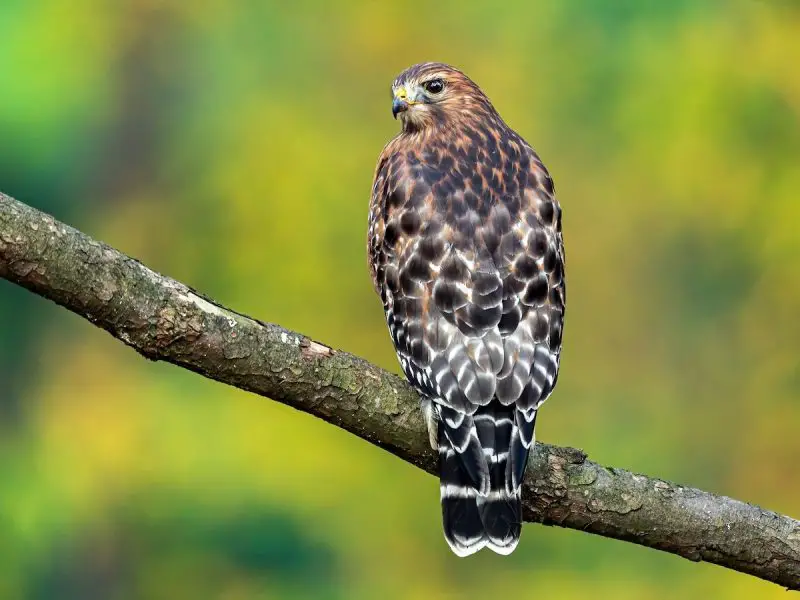
Red-shouldered Hawks are medium-sized raptors that stand out due to their striking reddish-brown shoulders and barred underparts. Their wings are broad and rounded, with distinctive black-and-white checkered patterns visible in flight. The tail has narrow white bands, which, along with their reddish chest, help distinguish them from similar species. Their vocalizations are loud, high-pitched, and repetitive, often echoing across wooded areas.
Adult Red-shouldered Hawks measure about 16 to 24 inches in length, with a wingspan of 37 to 43 inches. They have strong legs and sharp talons that allow them to capture amphibians, reptiles, and small mammals. Despite their moderate size, they are agile and efficient hunters capable of navigating dense forest habitats with precision.
In Texas, these hawks favor deciduous and mixed woodlands, river bottoms, and swampy areas where prey is abundant. Their diet mainly consists of small mammals, birds, frogs, and snakes. Red-shouldered Hawks often hunt from perches within forests, swooping down quickly to seize prey on the ground or in shallow water, and they are known for their patient, watchful hunting style.
Cooper’s Hawk
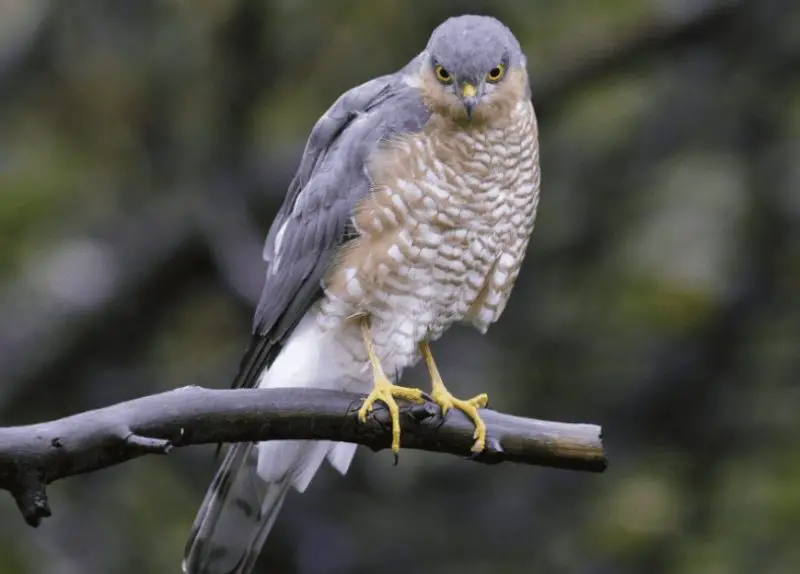
The Cooper’s Hawk is a medium-sized raptor known for its long tail and rounded wings, which make it highly maneuverable in forested environments. Adults have a bluish-gray back, reddish barring on the chest, and orange eyes that intensify with age. Juveniles display brown streaking instead of red, making them appear lighter and more mottled. This hawk’s slender build and long tail aid in rapid turns and precise hunting in dense trees.
Cooper’s Hawks range from 14 to 20 inches in length, with a wingspan of 24 to 39 inches. Males are noticeably smaller than females, but both exhibit strong talons and a hooked beak suitable for capturing birds mid-flight. Their compact size and agility make them adept at pursuing small to medium-sized birds through tight woodland corridors.
In Texas, Cooper’s Hawks primarily inhabit wooded areas, suburban neighborhoods, and forest edges, preying mostly on small birds, but they will also hunt rodents and insects if needed. They employ a stealthy hunting technique, often using surprise and quick bursts of speed to ambush prey from concealed perches or while gliding through dense vegetation.
Sharp-shinned Hawk
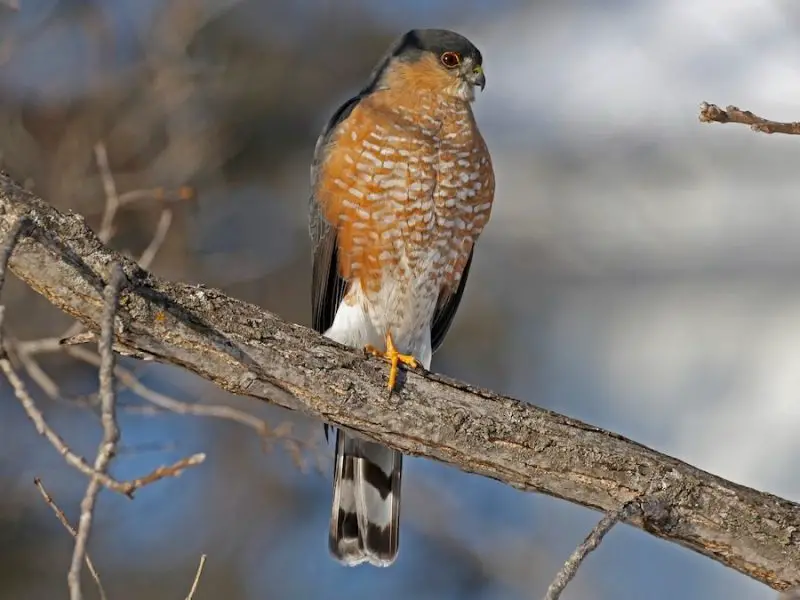
The Sharp-shinned Hawk is the smallest accipiter found in Texas, easily recognized by its short, rounded wings and long, narrow tail. Adults have blue-gray upperparts, orange barring on the chest, and striking yellow eyes. Juveniles display brown streaks and paler underparts, giving them a more mottled appearance. Their nimble build allows them to navigate thick shrubs and forests with remarkable speed and precision.
Measuring 9 to 13 inches in length, with a wingspan of 17 to 23 inches, the Sharp-shinned Hawk is compact but formidable. Its small size and sharp talons enable it to pursue and capture smaller birds in flight, often outmaneuvering prey with quick, agile movements. Despite being diminutive compared to other hawks, it is highly effective as a predator.
In Texas, Sharp-shinned Hawks are commonly found in forested regions, brushy edges, and urban parks. They feed mainly on songbirds, but they also hunt insects and small mammals when necessary. Their hunting style relies on stealth, speed, and surprise, often darting through dense trees to snatch unsuspecting birds with lightning-fast precision.
Swainson’s Hawk
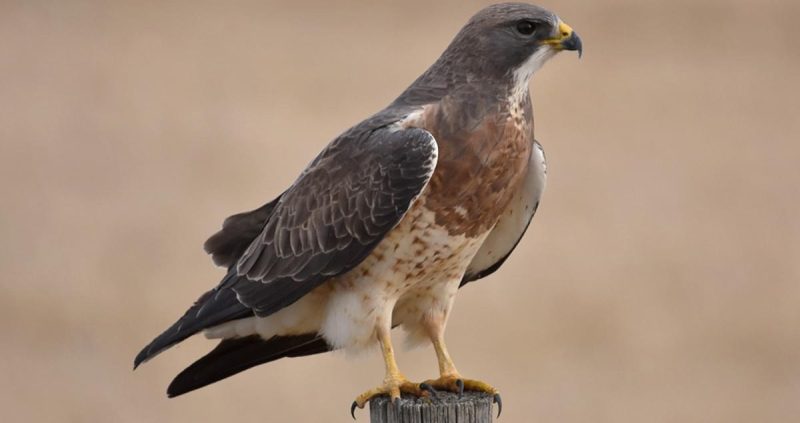
Swainson’s Hawks are large raptors with long, slender wings and a slightly rounded tail, giving them a graceful appearance in flight. Adults show a pale underside with a dark chest band and a rich brown back, while the head is often lighter with a subtle streaking pattern. Juveniles exhibit more mottled brown tones and less distinct markings. These hawks are highly migratory and are known for forming large flocks during seasonal movements.
Adults measure 18 to 26 inches in length, with a wingspan of 46 to 56 inches. They have powerful legs and talons, well-adapted for hunting and gripping prey. Despite their size, Swainson’s Hawks are surprisingly agile and can cover vast distances while soaring on thermals in search of food.
In Texas, Swainson’s Hawks favor open plains, grasslands, and agricultural fields where they can spot prey from the air. Their diet is diverse, primarily consisting of small mammals, insects, and occasionally birds. They often hunt by circling high above fields, spotting prey, and then gliding down with remarkable accuracy, making them one of the most efficient hunting hawks in the state.
Ferruginous Hawk
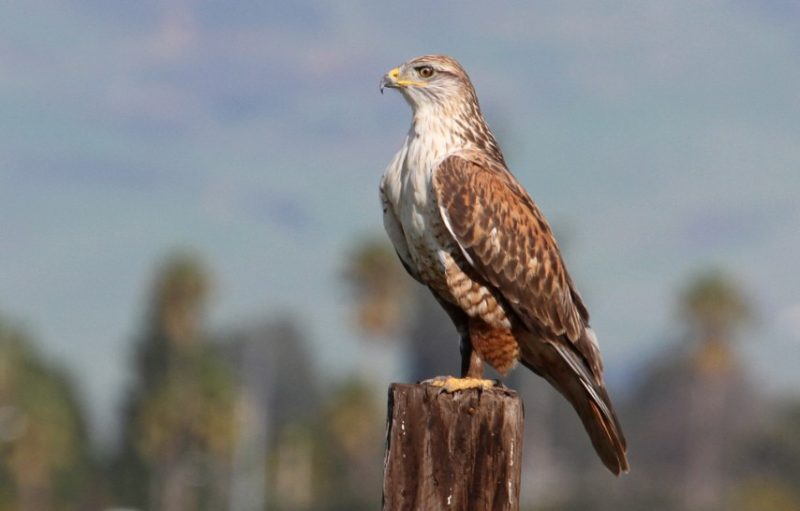
The Ferruginous Hawk is the largest hawk species in Texas, notable for its broad wings and massive size. Adults have a pale, creamy underside with rusty-colored legs and a rufous back, while their head is often streaked with brown. Juveniles display more extensive brown streaking on the chest and wings, making them appear darker overall. Their large, powerful beaks and talons are perfectly adapted for taking down sizable prey.
Measuring 20 to 28 inches in length, with a wingspan of 53 to 66 inches, Ferruginous Hawks are imposing birds of prey. Their size allows them to hunt larger mammals, and their broad wings enable effortless soaring over open plains and grasslands. Males are slightly smaller than females, but both exhibit the strength needed for gripping and killing prey.
In Texas, Ferruginous Hawks are typically found in wide-open prairies, deserts, and grasslands. Their diet primarily consists of rabbits, ground squirrels, prairie dogs, and occasionally birds or reptiles. They hunt from high perches or by soaring slowly over the ground, using their keen eyesight to locate prey from great distances before diving down with precision.
Harris’s Hawk
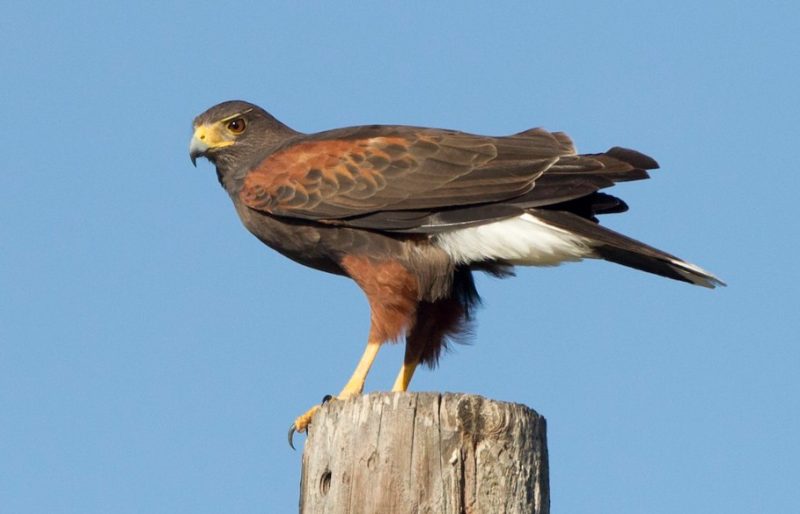
Harris’s Hawks are medium-sized raptors with striking dark brown plumage, chestnut shoulders, and white-tipped tails that stand out in flight. They are highly social compared to other hawks, often hunting in cooperative groups of two to five individuals. Their sharp eyes and agile flight make them formidable predators, especially in the brushy regions of Texas.
Adults range from 18 to 22 inches in length, with a wingspan of 42 to 48 inches. Their slender bodies and long legs help them pursue prey across varied terrain, and their strong talons allow them to capture mammals, reptiles, and birds. This species exhibits remarkable teamwork, sometimes flanking prey to corner it effectively.
In Texas, Harris’s Hawks inhabit semi-arid deserts, savannas, and scrublands, often near water sources. They feed mainly on rabbits, rodents, lizards, and medium-sized birds. Their cooperative hunting behavior enables them to tackle prey larger than themselves, and they frequently share perches and roosts, showcasing a unique social dynamic among raptors.
Broad-winged Hawk
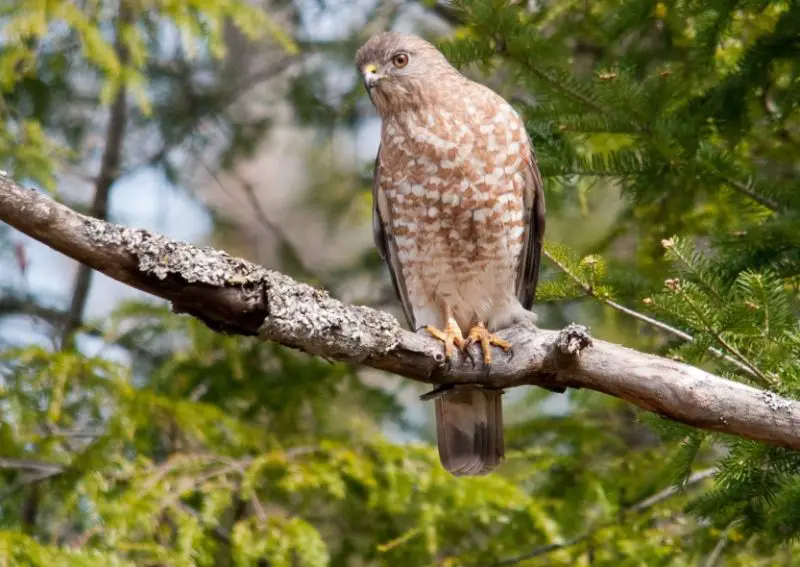
The Broad-winged Hawk is a small but robust raptor known for its short, broad wings and banded tail, making it highly maneuverable in wooded habitats. Adults have a brown back and a pale underside with rich, reddish-brown streaking on the chest. Juveniles are more mottled with lighter streaks, and both age groups are easily recognized by their distinctive whistling call.
Measuring 13 to 17 inches in length, with a wingspan of 31 to 39 inches, Broad-winged Hawks are compact yet strong hunters. Their short wings allow them to navigate dense forests with agility, while their sharp talons and hooked beak are suited for capturing small mammals, amphibians, and birds. Males are slightly smaller, but both sexes share similar hunting efficiency.
In Texas, Broad-winged Hawks are typically found in deciduous forests, riverine woodlands, and edges of mixed habitats. Their diet consists mainly of small mammals, reptiles, amphibians, and insects. They often hunt from concealed perches, launching short, rapid flights to snatch prey with precise strikes, demonstrating remarkable stealth and patience.
Northern Harrier

Northern Harriers are medium-sized raptors recognized for their owl-like facial disk, long tail, and low, gliding flight pattern over open fields. Adults exhibit gray or brown plumage, with males usually lighter than females, and both show white rump patches that are easily visible in flight. Juveniles are brown with streaked underparts, giving them a slightly mottled appearance.
Adults range from 17 to 20 inches in length, with a wingspan of 40 to 46 inches. Their long legs and sharp talons are suited for capturing small mammals, birds, and amphibians. Northern Harriers are unique among hawks for hunting by flying low over grasslands, using their acute hearing and sight to detect hidden prey.
In Texas, Northern Harriers favor marshes, grasslands, and agricultural fields where prey is plentiful. Their diet primarily consists of rodents, small birds, and occasionally amphibians or insects. They hunt methodically, flying just above the vegetation, listening and watching for movement, then swooping down to grab prey with precision and speed.
Zone-tailed Hawk
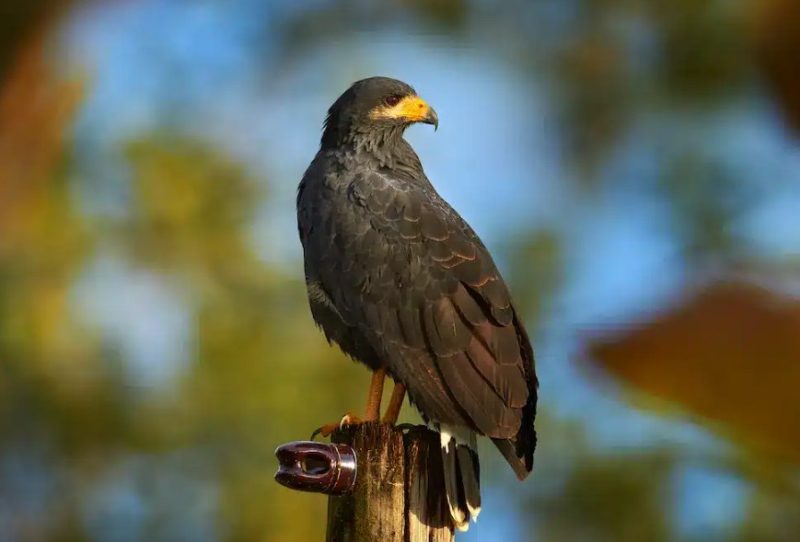
Zone-tailed Hawks are medium-sized raptors with dark plumage and faintly banded tails, often mistaken for Turkey Vultures due to their similar flight style. Adults have blackish-brown feathers with subtle white bands on the tail and wings, while juveniles are more streaked and lighter in tone. Their keen eyesight and broad wings allow them to soar effortlessly over wooded and open areas alike.
Adults measure 18 to 22 inches in length, with a wingspan of 46 to 54 inches. They possess strong legs and talons, capable of capturing reptiles, small mammals, and birds. Their stealthy hunting technique often involves gliding among Turkey Vultures to approach prey undetected, a strategy that makes them particularly effective predators.
In Texas, Zone-tailed Hawks are most commonly found in deserts, canyons, and open woodland regions. They primarily feed on reptiles, small mammals, and occasionally birds, using high-soaring vantage points to locate prey. Their flight style and mimicry of non-threatening vultures allow them to approach hunting grounds without alarming potential prey.
Bald Eagle
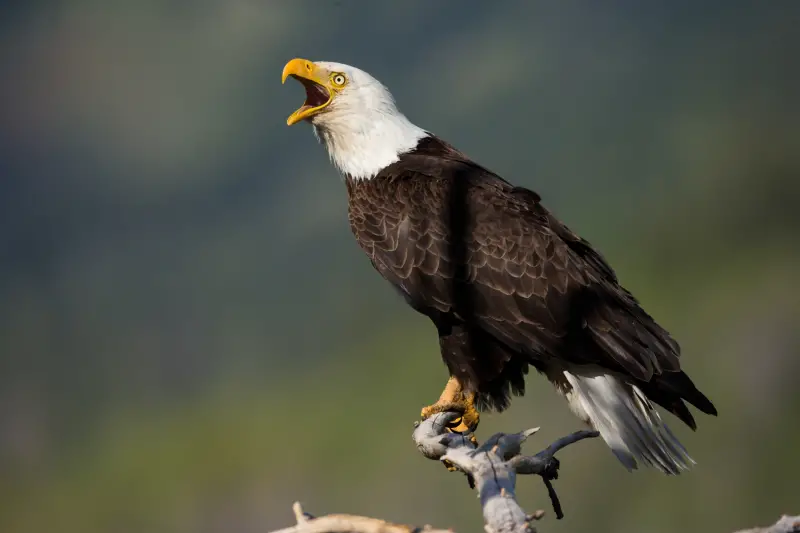
The Bald Eagle is an iconic bird of prey in Texas, easily recognized by its striking white head and tail contrasting with a dark brown body and wings. Adults have powerful yellow beaks, sharp talons, and piercing eyes that give them a regal appearance. Juveniles are mostly brown with mottled white patches and gradually develop the characteristic white head and tail over several years.
Bald Eagles are large raptors, measuring 28 to 40 inches in length, with a wingspan of 71 to 96 inches. Their size and strength make them capable hunters, and their broad wings allow for soaring high over lakes, rivers, and open fields. Females are larger than males, both equipped with strong legs and talons for capturing prey.
In Texas, Bald Eagles primarily inhabit rivers, lakes, and coastal areas where fish are abundant. Their diet consists mainly of fish, but they will also hunt waterfowl, small mammals, and scavenge carrion when needed. They often perch on tall trees or snags near water, scanning the area before swooping down with remarkable precision to seize prey.
Golden Eagle
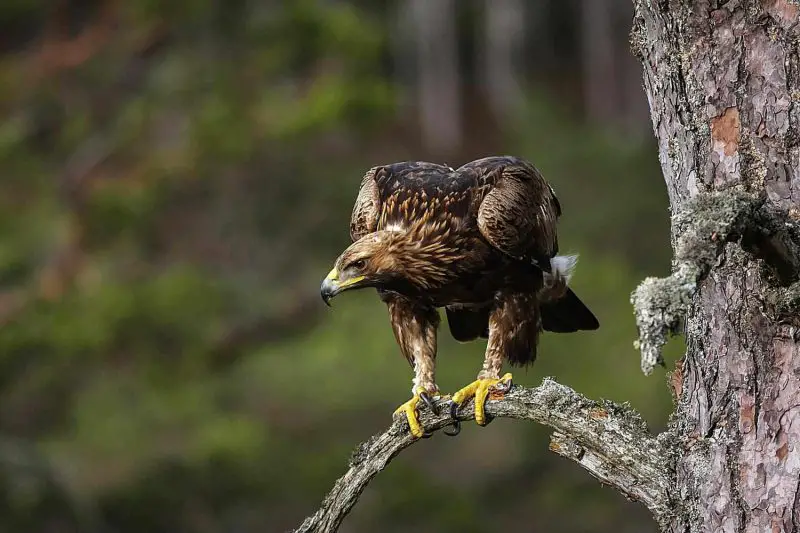
Golden Eagles are large, powerful raptors with dark brown plumage and golden feathers on the nape of the neck that give them their name. Their wings are long and broad, and their eyes are sharp and amber-colored. Juveniles have lighter brown mottling on their bodies and wings, making them slightly less striking than adults but still formidable in appearance.
Adults measure 26 to 40 inches in length, with a wingspan of 72 to 90 inches. Golden Eagles possess strong talons and a hooked beak, ideal for grasping and killing medium-sized mammals. They are agile in the air for their size, capable of rapid dives and sustained soaring over open landscapes.
In Texas, Golden Eagles are typically found in open plains, deserts, and mountainous regions. Their diet includes rabbits, squirrels, prairie dogs, and occasionally birds or reptiles. They often hunt by soaring at great heights, spotting prey with keen eyesight, and then descending rapidly to strike with powerful talons.
American Kestrel
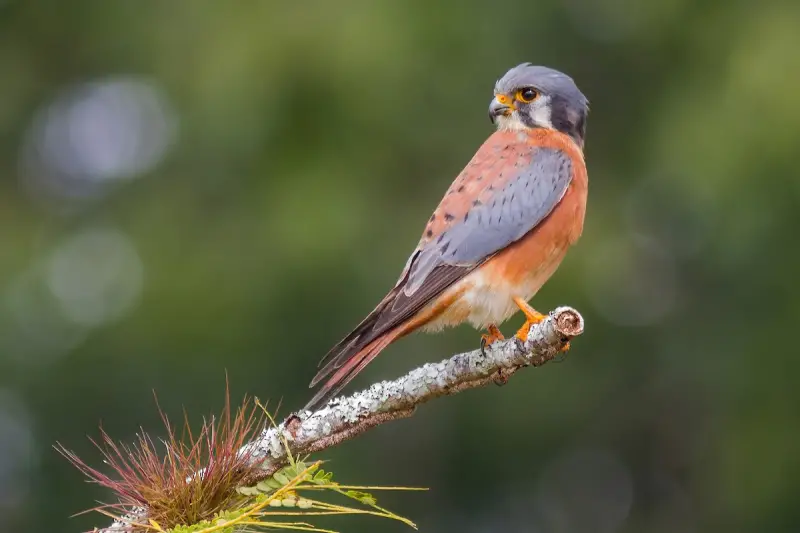
The American Kestrel is the smallest falcon in Texas, noted for its colorful plumage with a combination of rufous, blue-gray, and black markings. Males display a blue-gray head and wings with reddish back and tail, while females are more uniformly rufous with streaked backs. Both sexes have two distinct facial stripes that enhance their alert expression.
Measuring 8 to 12 inches in length, with a wingspan of 20 to 24 inches, American Kestrels are small but efficient hunters. They hover in the air to locate prey before diving swiftly to capture insects, small mammals, or birds. Their size allows them to maneuver skillfully around trees, poles, and urban structures.
In Texas, American Kestrels inhabit open fields, grasslands, and urban areas where prey is plentiful. They feed on insects, small birds, and rodents, often hunting from perches or while hovering above open terrain. Their agility and keen eyesight make them exceptionally effective predators despite their small size.
Merlin
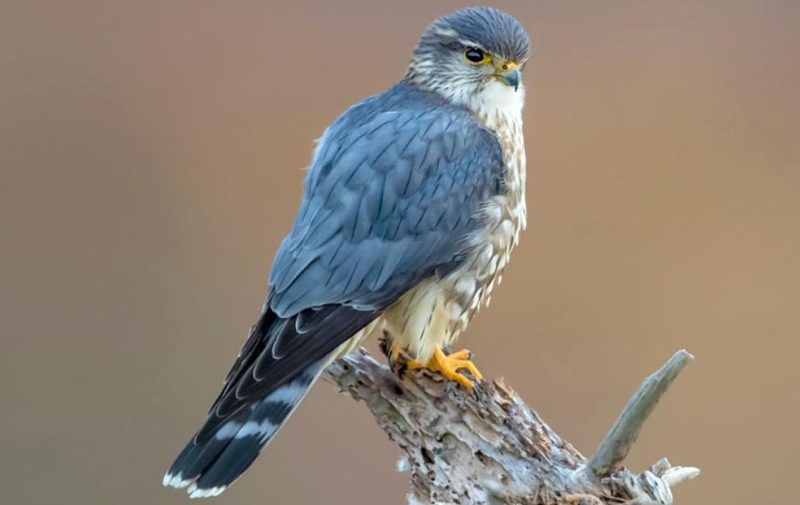
Merlins are small, fast-flying falcons with dark streaked plumage and a compact, muscular body. Adults have blue-gray backs and finely streaked underparts, while juveniles appear more brown with heavy streaking. They have a fierce gaze and sharp beak, reflecting their predatory nature. Their rapid wingbeats allow them to chase prey through dense vegetation or open skies.
Merlins measure 9 to 13 inches in length, with a wingspan of 20 to 27 inches. Their small, powerful build enables them to pursue birds in flight, often catching prey mid-air. Both sexes are similarly built, with females slightly larger, allowing them to tackle slightly larger prey.
In Texas, Merlins prefer open woodlands, fields, and urban areas where small birds are abundant. Their diet consists mainly of small songbirds, occasionally supplemented with insects or rodents. They hunt with rapid, direct flight, using speed and agility to surprise and capture prey with precision.
Peregrine Falcon
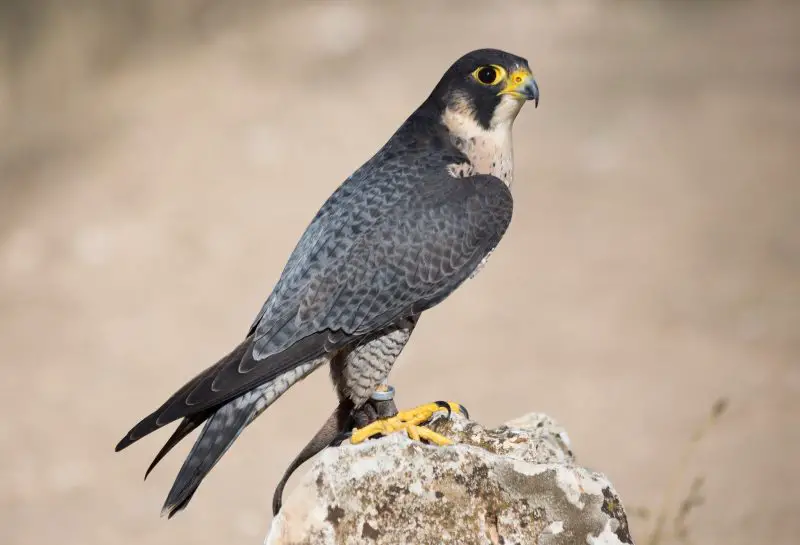
Peregrine Falcons are renowned for their incredible speed and aerial hunting skills. Adults display slate-gray wings, a dark head, and barred underparts, while juveniles are brown with streaked chests. Their sharp beak and powerful talons are perfectly adapted for striking and killing birds mid-flight.
Adults measure 13 to 23 inches in length, with a wingspan of 31 to 47 inches. Peregrine Falcons are among the fastest animals on Earth, capable of reaching speeds over 200 mph during stoops. Their muscular build and aerodynamic shape make them highly efficient hunters, with both sexes sharing similar predatory abilities.
In Texas, Peregrine Falcons inhabit cliffs, urban skyscrapers, and open areas where birds are abundant. Their diet consists almost exclusively of birds, which they capture in dramatic high-speed dives. They rely on keen eyesight, speed, and precision to hunt successfully, often striking prey mid-air with a lethal impact.
Prairie Falcon
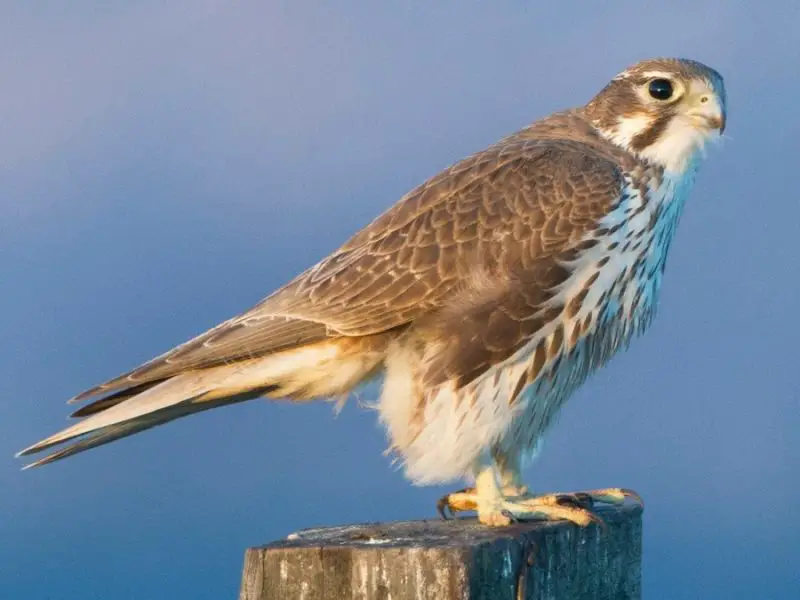
Prairie Falcons are medium-sized falcons with sandy-brown plumage, dark “mustache” marks on their face, and barred underparts. Adults have long, pointed wings and a slightly notched tail, while juveniles appear more mottled with streaked underparts. They are adapted for life in open habitats, using both soaring and rapid flight to hunt efficiently.
Adults range from 15 to 20 inches in length, with a wingspan of 39 to 43 inches. Prairie Falcons have strong talons and sharp beaks that allow them to capture birds, small mammals, and insects. Their build combines speed, agility, and endurance for hunting over plains and deserts.
In Texas, Prairie Falcons prefer open grasslands, deserts, and agricultural fields. They feed on small mammals, birds, and insects, often hunting by soaring high to spot prey and then diving with precision. Their ability to cover large areas while searching for food makes them highly effective hunters in the wide-open landscapes of the state.
Mississippi Kite
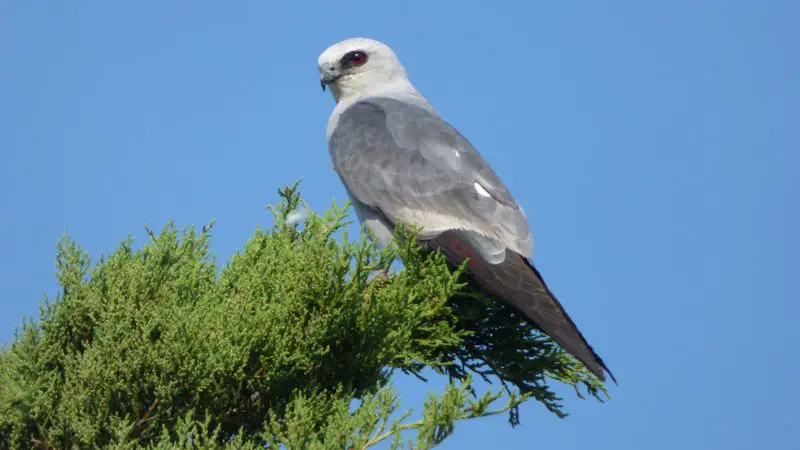
The Mississippi Kite is a slender, medium-sized raptor with a graceful appearance and smooth, gray plumage. Adults have dark gray wings and back, a lighter gray underside, and bright red eyes that stand out in sunlight. Juveniles are browner with streaked underparts, making them appear less uniform than adults. Their long, pointed wings and deeply forked tails allow for agile, buoyant flight, often resembling gliders.
Adults measure 14 to 18 inches in length, with a wingspan of 35 to 39 inches. Despite their modest size, they have strong talons and a hooked beak suited for catching insects and small vertebrates. Both sexes are similar in size and coloration, making them efficient aerial hunters capable of pursuing agile prey mid-air.
In Texas, Mississippi Kites favor open woodlands, river valleys, and grasslands. They primarily feed on flying insects such as dragonflies, grasshoppers, and beetles, occasionally catching small birds and lizards. These birds often hunt in the air, swooping and gliding gracefully to snatch prey, and are known for gathering in large, social flocks during migration.
Swallow-tailed Kite
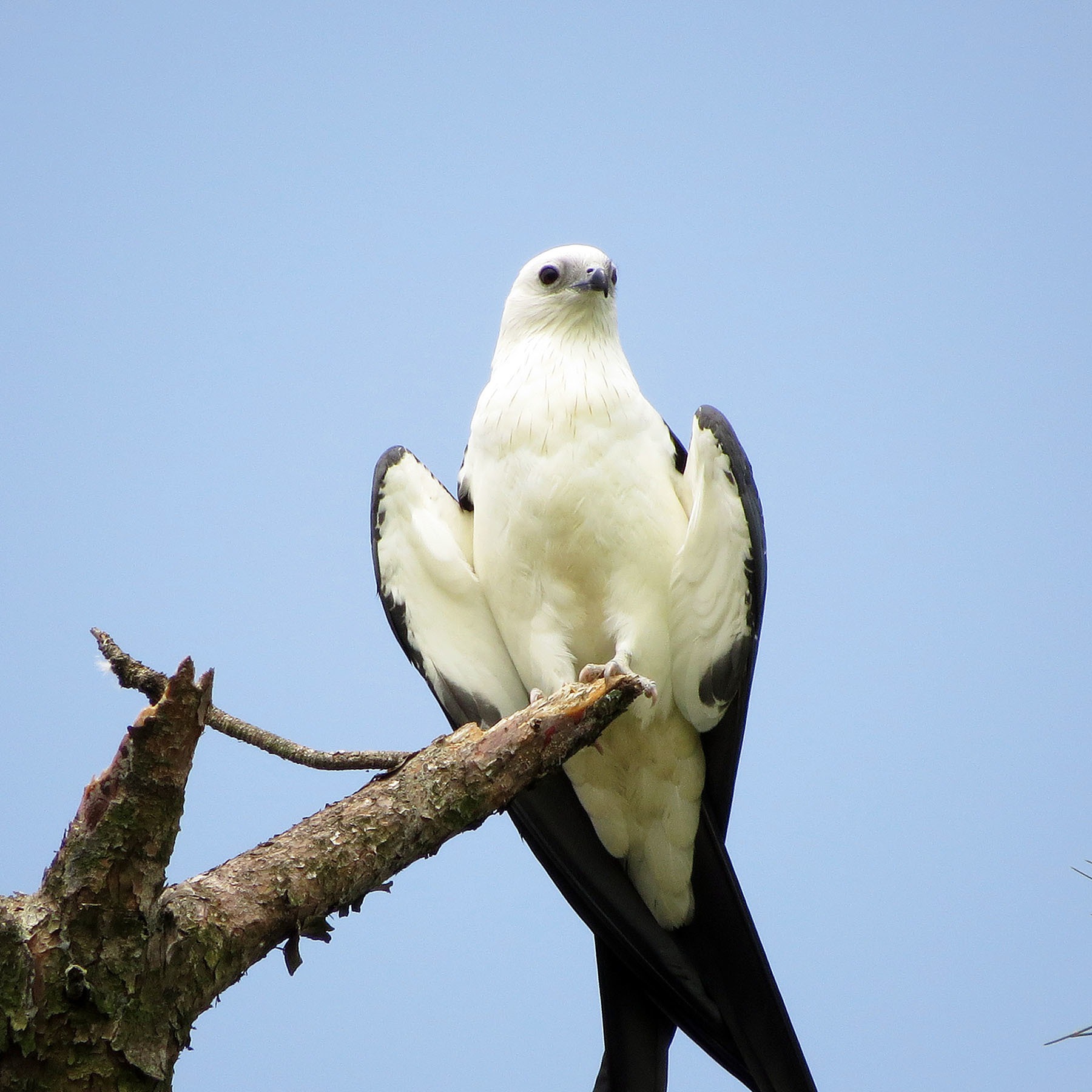
Swallow-tailed Kites are elegant raptors recognized for their deeply forked tails, long, slender wings, and striking black-and-white plumage. Adults have a white body with black wings and tail, while juveniles are grayer with less defined contrasts. Their aerial acrobatics make them among the most graceful hunters, often seen gliding and twisting through the sky.
Adults range from 21 to 25 inches in length, with a wingspan of 48 to 60 inches. They have relatively small feet and talons compared to other raptors, reflecting their diet of insects and small vertebrates caught in flight. Their long wings and lightweight body allow for prolonged soaring and precision maneuvering.
In Texas, Swallow-tailed Kites favor river bottoms, wetlands, and forest edges. They feed mainly on insects, lizards, and small birds, catching prey during agile aerial maneuvers. These birds are highly social and often observed in small groups or pairs, gliding effortlessly above the treetops as they hunt.
Turkey Vulture
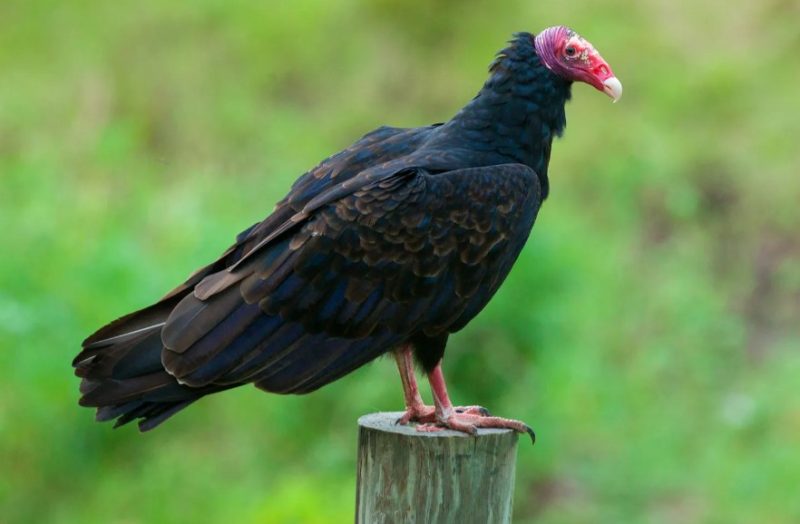
Turkey Vultures are large scavenging birds easily identified by their red, featherless heads and dark brown body and wing feathers. Juveniles have darker heads, which gradually turn red as they mature. Their broad wings and slightly upturned wingtips allow them to soar effortlessly, often in large groups, as they search for carrion.
Adults measure 25 to 32 inches in length, with a wingspan of 63 to 72 inches. Despite their size, their feet are weak and not designed for grasping prey, as they feed exclusively on carrion. Both sexes appear similar, making them easy to recognize by their soaring flight and distinctive V-shaped wing posture.
In Texas, Turkey Vultures inhabit open fields, grasslands, deserts, and forests, relying on their excellent sense of smell to locate decaying animals. They play a crucial ecological role as scavengers, cleaning up carcasses and helping prevent the spread of disease. They often glide high in the sky, riding thermals for hours while searching for food.
Black Vulture
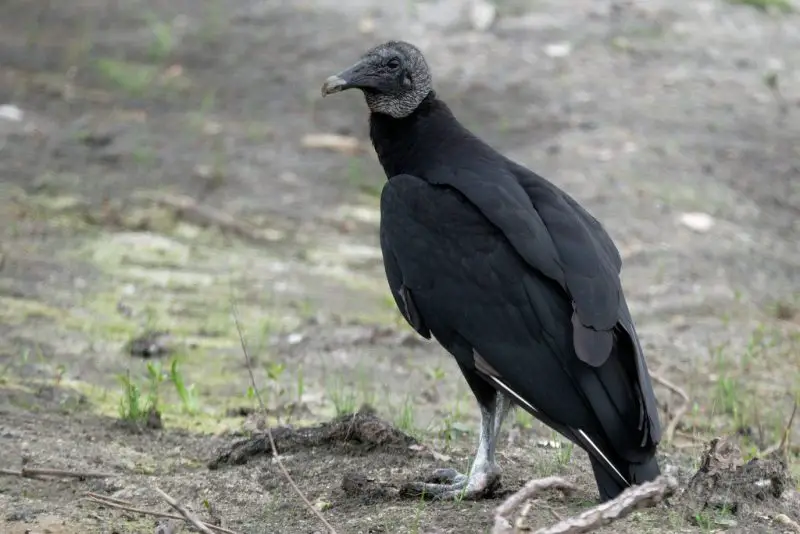
Black Vultures are medium to large scavenging birds with all-black plumage, short tails, and bare, dark gray heads. Juveniles are uniformly black with slightly darker heads, while adults show wrinkled skin on their heads and necks. Their broad wings have white patches near the tips, visible in flight, which helps distinguish them from Turkey Vultures.
Adults measure 24 to 30 inches in length, with a wingspan of 52 to 66 inches. Like other vultures, their feet are not designed for hunting, and they rely on scavenging for survival. Males and females look alike, both possessing strong stomach acids that allow them to safely digest carrion.
In Texas, Black Vultures frequent open fields, roadsides, and landfills, often feeding on carrion alongside Turkey Vultures. They use keen eyesight to locate food and are more aggressive than Turkey Vultures, sometimes displacing them from carcasses. These vultures also soar using thermals, covering large areas while conserving energy.
Great Horned Owl
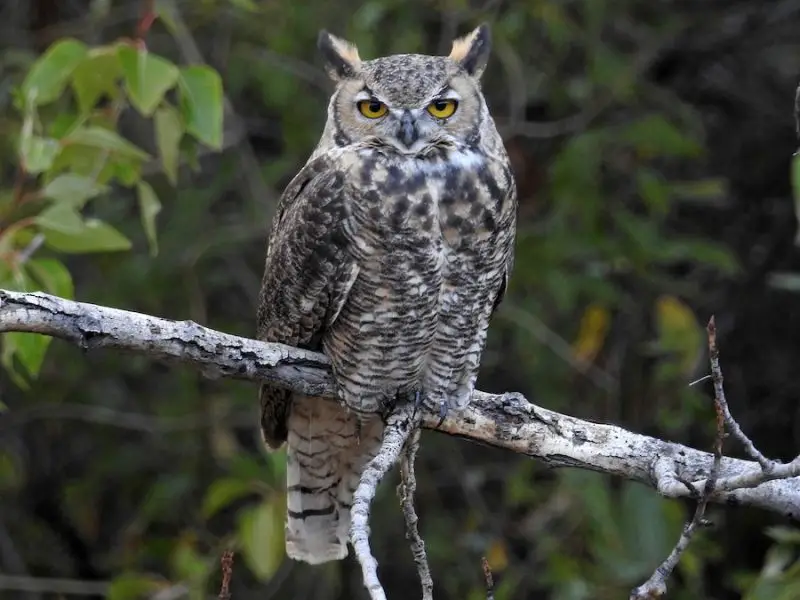
The Great Horned Owl is a large, powerful raptor easily recognized by its prominent ear tufts, mottled brown plumage, and striking yellow eyes. Its facial disk is well-defined, helping direct sound to its sensitive ears, and the overall plumage provides excellent camouflage against tree bark. Juveniles are fluffier and lighter in coloration but rapidly develop adult features within the first year.
Adults measure 18 to 25 inches in length, with a wingspan of 39 to 57 inches. Their robust build, strong talons, and hooked beak make them capable of hunting a wide range of prey, from small mammals to birds and reptiles. Males are slightly smaller than females, but both exhibit similar predatory skills.
In Texas, Great Horned Owls inhabit forests, woodlands, urban areas, and grasslands. They are primarily nocturnal hunters, preying on rabbits, squirrels, raccoons, birds, and occasionally snakes. They rely on silent flight, keen hearing, and excellent night vision to ambush prey with remarkable stealth.
Barn Owl
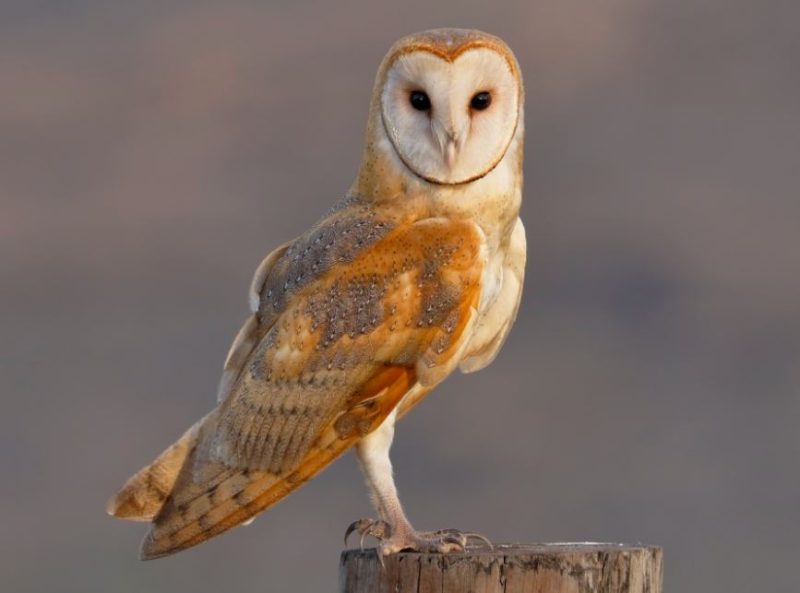
Barn Owls are medium-sized owls with a distinctive heart-shaped facial disk, pale buff and white plumage, and dark eyes. Adults display mottled gray and golden-brown upperparts, while juveniles appear slightly more uniform with softer, downy feathers. Their facial shape enhances hearing, making them highly efficient at detecting prey in low-light conditions.
Adults measure 12 to 15 inches in length, with a wingspan of 31 to 37 inches. They have long legs and sharp talons suited for capturing small mammals. Both sexes look similar, though females may appear slightly larger. Their lightweight build allows for near-silent flight, essential for hunting in open fields at night.
In Texas, Barn Owls favor open grasslands, agricultural areas, and barns or abandoned structures. Their diet consists mainly of rodents such as mice and voles, but they occasionally take birds or insects. They hunt by flying low over the ground, using acute hearing and vision to locate and silently swoop down on prey.
Eastern Screech-Owl
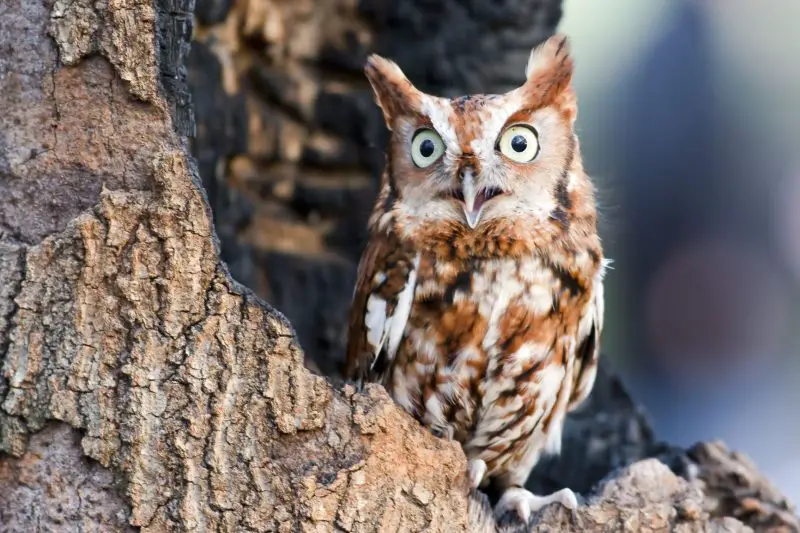
The Eastern Screech-Owl is a small, cryptically colored raptor with a stocky build, short wings, and a small, ear-tufted head. Adults display gray or reddish-brown plumage with intricate streaks and mottling, providing excellent camouflage in tree bark. Juveniles are fluffier and less patterned but quickly develop adult coloration.
Adults measure 6 to 10 inches in length, with a wingspan of 18 to 24 inches. Despite their small size, they have strong talons and a sharp beak capable of catching insects, small mammals, and birds. Males and females are similar in appearance, with females slightly larger in most cases.
In Texas, Eastern Screech-Owls inhabit woodlands, suburban areas, and tree-lined landscapes. They are nocturnal hunters, feeding primarily on insects, rodents, and small birds. They often perch quietly during the day and emerge at dusk, using stealth and patience to capture prey efficiently.
Western Screech-Owl

Western Screech-Owls are small, stocky owls similar in shape to the Eastern Screech-Owl but adapted to western and central habitats. Adults have grayish or brown plumage with intricate streaks and mottling that blend into tree bark. Juveniles are soft and fluffy, gradually developing the more defined patterns of adults within their first year.
Adults measure 7 to 10 inches in length, with a wingspan of 18 to 24 inches. They have strong talons and a hooked beak suitable for catching insects, small mammals, and birds. Males and females are visually similar, though females tend to be slightly larger.
In Texas, Western Screech-Owls are found in woodlands, canyons, and suburban areas with trees or snags for nesting. They are primarily nocturnal, feeding on insects, small mammals, and occasional birds. Their hunting style relies on stealth and surprise, often pouncing from perches or swooping silently to capture prey.
Burrowing Owl
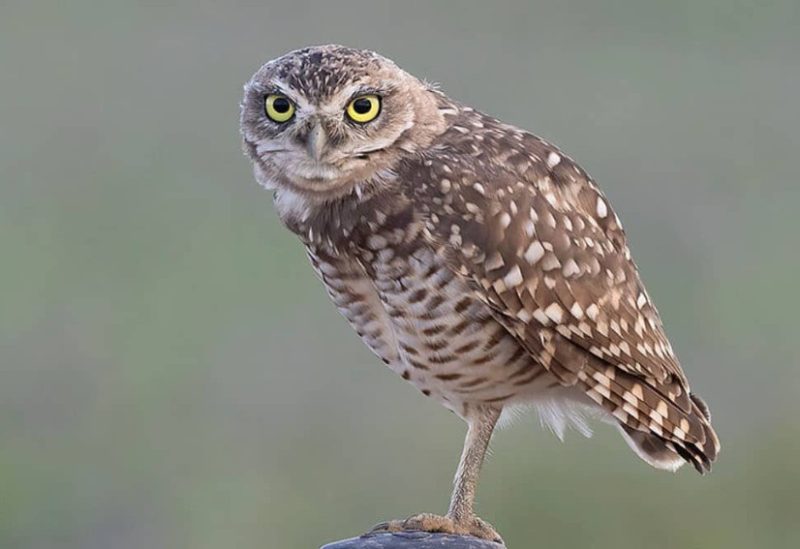
Burrowing Owls are small, ground-dwelling raptors with long legs, mottled brown plumage, and bright yellow eyes. Adults have white facial disks and a streaked chest, while juveniles appear lighter and fuzzier with less distinct markings. They are unique among owls for nesting and living in burrows, often created by prairie dogs or other mammals.
Adults measure 7.5 to 10 inches in length, with a wingspan of 20 to 24 inches. Despite their small size, they possess sharp talons and a strong beak for capturing insects, small mammals, and occasionally reptiles. Males and females are similar in appearance and hunting ability.
In Texas, Burrowing Owls inhabit open grasslands, prairies, and desert areas with suitable burrows. They are mostly active during the day or at dusk, hunting insects, small rodents, and other invertebrates. Their unique ground-based lifestyle requires vigilance and agility to avoid predators while foraging.
Barred Owl
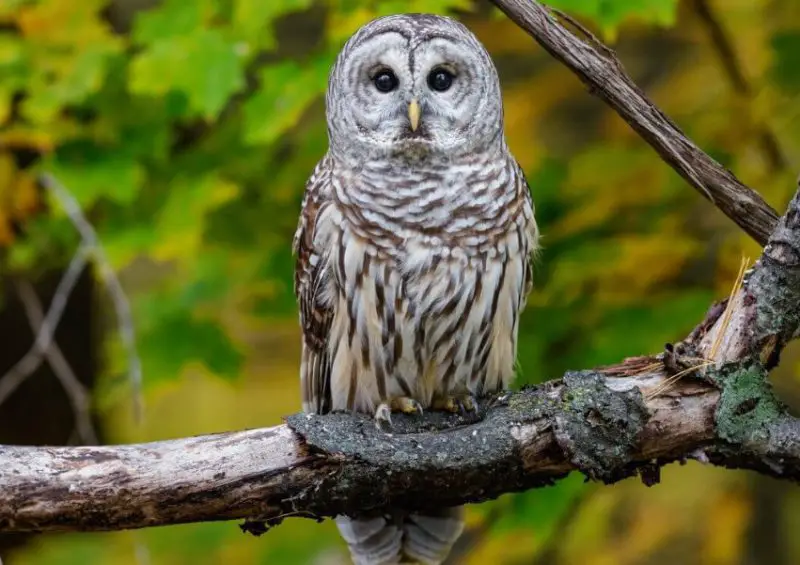
Barred Owls are medium to large forest-dwelling owls with a round head, no ear tufts, and striking brown-and-white barred plumage on the chest. Adults have dark eyes and a pale facial disk, while juveniles are fluffier with less defined barring. Their distinctive hooting call is often heard in wooded areas across Texas.
Adults measure 16 to 25 inches in length, with a wingspan of 38 to 49 inches. They have strong talons and a hooked beak, capable of catching a variety of prey including small mammals, birds, amphibians, and reptiles. Both sexes appear similar, with females slightly larger on average.
In Texas, Barred Owls inhabit dense forests, river bottoms, and wooded wetlands. They are nocturnal hunters, relying on acute hearing and vision to locate prey in low-light conditions. They often perch quietly and swoop silently onto prey, demonstrating remarkable stealth and patience in their hunting strategy.
Short-eared Owl
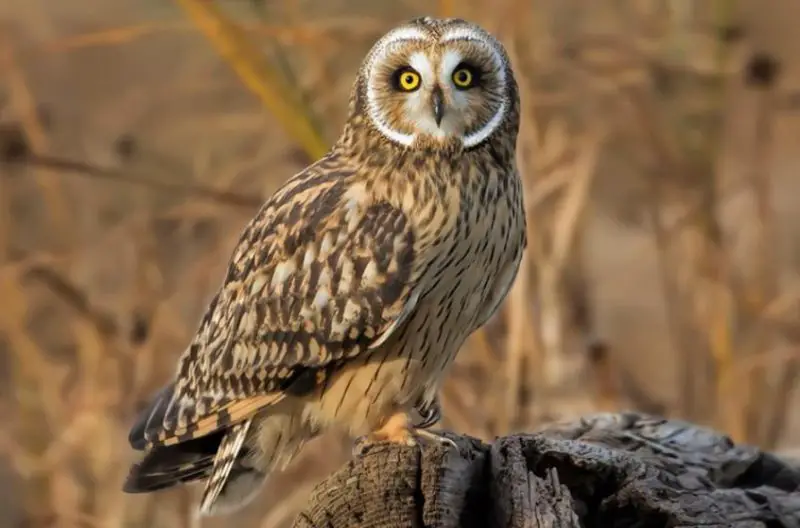
The Short-eared Owl is a medium-sized raptor easily recognized by its rounded head, yellow eyes, and small ear tufts that are often barely visible. Its plumage is mottled brown and buff with streaked underparts, providing excellent camouflage in grasslands and open fields. Juveniles are slightly paler and fluffier, blending well with their surroundings.
Adults measure 13 to 17 inches in length, with a wingspan of 33 to 43 inches. They have long wings and strong talons adapted for hunting small mammals. Both sexes appear similar, and their agile flight allows them to hover and glide low over open terrain while scanning for prey.
In Texas, Short-eared Owls inhabit grasslands, prairies, and marshy meadows. They primarily feed on small mammals such as voles, mice, and shrews. These owls are often active during the day, especially at dawn and dusk, hunting by slowly flying just above the vegetation and swooping down to capture prey with precision.
Long-eared Owl
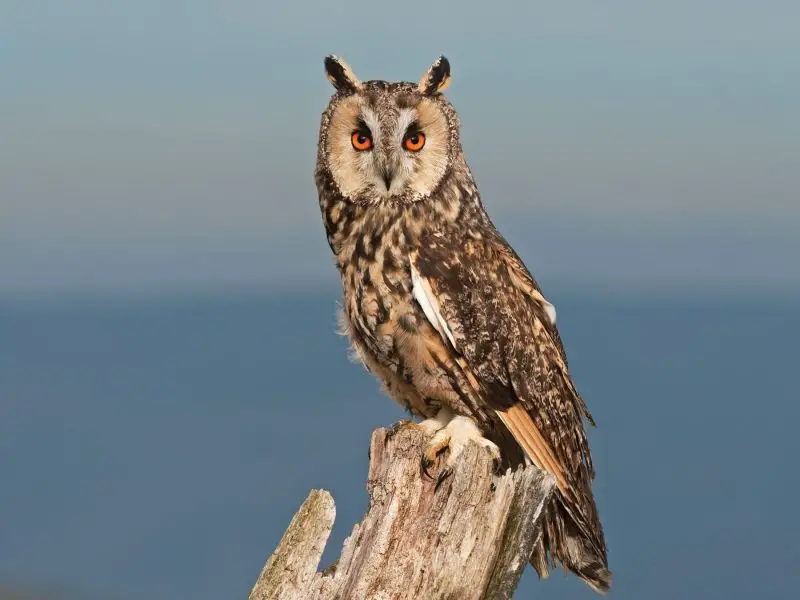
The Long-eared Owl is a medium-sized, slender owl with long ear tufts, orange eyes, and a streaked brown and buff plumage that helps it blend into forested environments. Adults have a narrow, elongated facial disk, while juveniles are fluffier and less patterned but quickly develop adult markings. Their stealthy appearance allows them to remain virtually invisible when roosting in dense trees.
Adults measure 13 to 16 inches in length, with a wingspan of 35 to 39 inches. Their sharp talons and hooked beak are adapted for capturing small mammals and birds. Males and females are similar in appearance, though females are slightly larger and more robust.
In Texas, Long-eared Owls are found in wooded areas, forest edges, and shrublands. They are primarily nocturnal hunters, feeding on rodents, small birds, and insects. They often hunt from perches or glide silently through dense vegetation, relying on acute hearing and vision to detect prey.
Northern Saw-whet Owl
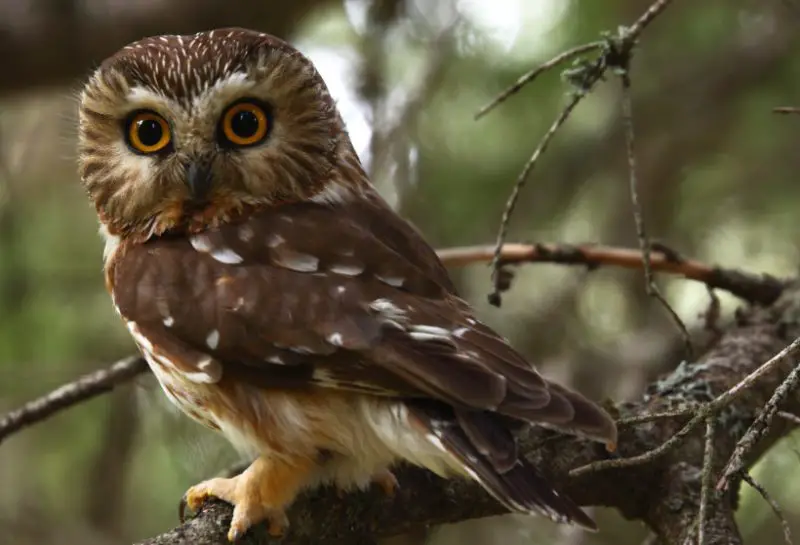
The Northern Saw-whet Owl is a tiny, compact owl with a rounded head, large yellow eyes, and brown-streaked white plumage. Adults have a soft, downy appearance, while juveniles appear even fluffier with less distinct markings. Their small size and agile flight allow them to hunt quietly through dense forests.
Adults measure 7 to 8 inches in length, with a wingspan of 16 to 19 inches. They have sharp talons and a hooked beak suitable for catching small mammals and insects. Both sexes appear similar, with females slightly larger in some cases.
In Texas, Northern Saw-whet Owls inhabit dense forests, wooded riparian areas, and brushy habitats. They feed primarily on small mammals such as mice and voles, occasionally supplementing their diet with insects. They are nocturnal hunters, relying on stealth and keen senses to capture prey in low-light conditions.
Zone-tailed Hawk

Zone-tailed Hawks are medium-sized raptors with dark plumage, faintly banded tails, and broad wings. Their flight closely resembles that of Turkey Vultures, often allowing them to approach prey unnoticed. Adults have blackish-brown feathers with subtle white bands on the tail and wings, while juveniles are more streaked and lighter in tone.
Adults measure 18 to 22 inches in length, with a wingspan of 46 to 54 inches. Their strong talons and hooked beak enable them to capture reptiles, small mammals, and birds. Both sexes appear similar, sharing efficient hunting abilities.
In Texas, Zone-tailed Hawks inhabit deserts, open woodlands, and canyons. They primarily feed on reptiles, small mammals, and occasionally birds. Their soaring flight and mimicry of vultures help them approach hunting areas without alarming prey, making them effective and stealthy predators.
Osprey
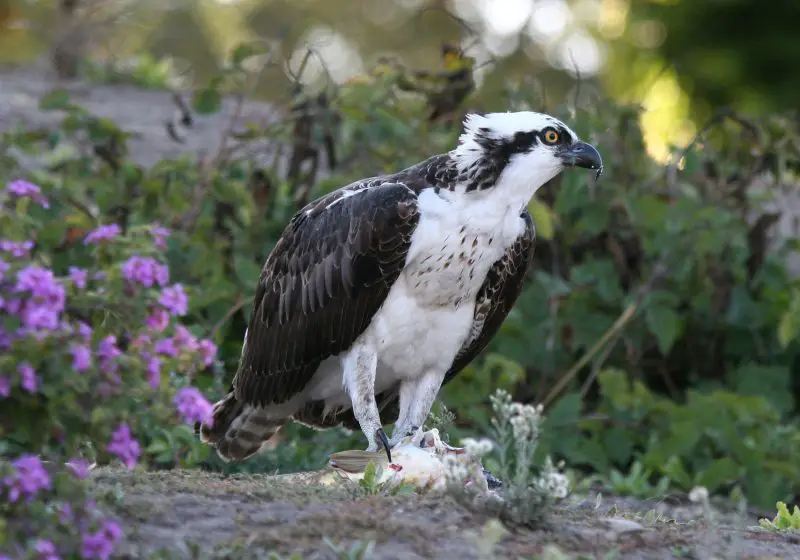
Ospreys are large raptors with distinctive white underparts, dark brown upperparts, and a dark eye stripe extending to the sides of their head. Adults have long, narrow wings and a hooked beak, while juveniles appear browner with streaked underparts. Their reversible outer toes allow them to grasp slippery fish securely, their primary prey.
Adults measure 21 to 26 inches in length, with a wingspan of 59 to 71 inches. They have strong talons and curved beaks adapted specifically for catching fish. Both sexes share similar size and hunting abilities, though females tend to be slightly larger.
In Texas, Ospreys inhabit rivers, lakes, reservoirs, and coastal areas. They feed almost exclusively on fish, diving feet-first into water to snatch prey with precision. Ospreys are often seen hovering or gliding over water bodies, scanning for fish before making rapid, controlled dives.
Crested Caracara

The Crested Caracara is a medium-sized raptor with striking black-and-white plumage, a bare orange face, and a hooked beak. Adults have black caps and wings with white necks and underparts, while juveniles are browner and more mottled. This species is often observed walking on the ground as well as flying, displaying both predatory and scavenging behaviors.
Adults measure 19 to 23 inches in length, with a wingspan of 47 to 52 inches. They have strong legs and talons capable of capturing small mammals, reptiles, and carrion. Both sexes appear similar in size and coloration, making them equally effective hunters and scavengers.
In Texas, Crested Caracaras inhabit grasslands, savannas, and open deserts. They feed on small animals, insects, and carrion, often hunting on foot in addition to aerial hunting. They are opportunistic feeders and are frequently seen soaring or walking across open fields in search of food.
FAQs about Birds of Prey in Texas
What are the most common birds of prey in Texas?
Texas hosts a wide variety of raptors, including hawks, eagles, falcons, kites, and owls. Some of the most common species are the Red-tailed Hawk, Cooper’s Hawk, Swainson’s Hawk, Bald Eagle, and Osprey. These birds inhabit diverse habitats such as forests, grasslands, wetlands, and urban areas.
How can I identify a Red-tailed Hawk?
Red-tailed Hawks are large raptors with broad, rounded wings and a distinctive rusty-red tail. Adults have pale underparts with a streaked belly band and dark eyes. They are often seen perched on high vantage points like trees or poles, scanning for small mammals, birds, and reptiles.
Where do Ferruginous Hawks live in Texas?
Ferruginous Hawks are typically found in open prairies, deserts, and grasslands. They prefer wide, open spaces where they can soar slowly over the ground to spot prey such as rabbits, prairie dogs, and other small mammals.
What do Ospreys eat?
Ospreys primarily feed on fish. They are specially adapted with reversible outer toes and sharp talons to grasp slippery prey. Ospreys hunt by hovering over water bodies and diving feet-first to catch fish.
Are Zone-tailed Hawks common in Texas?
Zone-tailed Hawks are less commonly seen than other hawks but inhabit deserts, open woodlands, and canyons in Texas. They are often mistaken for Turkey Vultures due to their similar flight style, which helps them approach prey without being noticed.
How do Burrowing Owls hunt?
Burrowing Owls hunt mainly during the day or at dusk, feeding on insects, small mammals, and occasionally reptiles. They use a combination of ground-based movement and hovering flight to locate and capture prey.
Can Bald Eagles be found year-round in Texas?
Bald Eagles are more commonly seen during the winter months when they migrate south from northern states. However, some populations remain year-round near large lakes, rivers, and coastal areas where fish are plentiful.
What is unique about Crested Caracaras?
Crested Caracaras are versatile birds that hunt and scavenge. Unlike many raptors, they are frequently observed walking on the ground to find prey or carrion. They inhabit open grasslands, savannas, and deserts in Texas.
How can I distinguish a Swallow-tailed Kite?
Swallow-tailed Kites have a striking black-and-white plumage and deeply forked tails. They are graceful aerial hunters, often gliding and twisting through the air while catching insects, small birds, and lizards.
Are Black Vultures dangerous to humans?
Black Vultures are scavengers and generally not dangerous to humans. They feed primarily on carrion and occasionally small animals. However, they can be aggressive toward other birds at a carcass but typically avoid direct contact with people.
How do owls in Texas differ from hawks?
Owls are primarily nocturnal and have specialized adaptations such as silent flight, large eyes for night vision, and facial disks for enhanced hearing. Hawks are usually diurnal, relying on keen eyesight and soaring flight to hunt during the day.
Which bird of prey in Texas is the fastest?
The Peregrine Falcon is the fastest bird of prey in Texas and the world. It can reach speeds over 200 mph during its hunting stoop, diving from high altitudes to strike birds mid-air with lethal precision.
Do Harris’s Hawks hunt alone?
Harris’s Hawks are unique among raptors because they often hunt cooperatively in groups of two to five. This teamwork allows them to corner larger prey and increases hunting success in their semi-arid Texas habitats.

